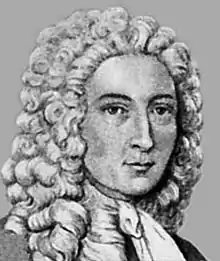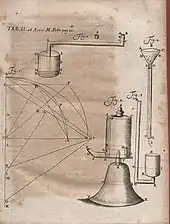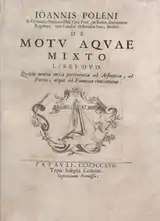Giovanni Poleni
Giovanni Poleni FRS (Italian pronunciation: [dʒoˈvanni ˈpolɛni]; 23 August 1683 – 15 November 1761) was a Marquess, physicist, mathematician and antiquarian.[1]
Giovanni Poleni | |
|---|---|
 | |
| Born | August 23, 1683 |
| Died | 15 November 1761 (aged 78) |
| Resting place | Basilica del Carmine, Padua |
| Occupation(s) | Physicist, mathematician and antiquarian |
| Spouse | Orsola Roberti[1] |
| Children | 6 |
| Parent(s) | Giacomo Poleni and Isabella Poleni (née de' Brugnol)[1] |
| Scientific career | |
| Institutions | University of Padua[1] |
Early life
He was the son of Marquess Jacopo Poleni and studied the classics, philosophy, theology, mathematics, and physics at the School of the Somaschi Fathers, Venice.
Career
He was appointed, at the age of twenty-five, professor of astronomy at Padua. In 1715 he was assigned to the chair of physics, and in 1719 he succeeded Nicholas II Bernoulli as professor of mathematics. As an expert in hydraulic engineering he was charged by the Venetian Senate with the care of the waters of lower Lombardy and with the constructions necessary to prevent floods. He was also repeatedly called in to decide cases between sovereigns whose states were bordered by waterways.
Poleni was the first to build a calculator that used a pinwheel design. Made of wood, his calculating clock was built in 1709;[2] he destroyed it after hearing that Anton Braun had received 10,000 Guldens for dedicating a pinwheel machine of his own design to the emperor Charles VI of Vienna.[3] Poleni described his machine in his Miscellanea in 1709, but it was also described by Jacob Leupold in his Theatrum Machinarum Generale ("The General Theory of Machines") which was published in 1727. In 1729, he also built a tractional device that enabled logarithmic functions to be drawn.
Poleni's observations on the impact of falling weights (similar to Willem 's Gravesande's) led to a controversy with Samuel Clarke and other Newtonians that became a part of the so-called "vis viva dispute" in the history of classical mechanics.[4]
His knowledge of architecture caused Benedict XIV to call him to Rome in 1748 to examine the cupola of St. Peter's, which was rapidly disintegrating. As part of the structural investigation of the dome he used a correctly loaded hanging chain to determine its funicular shape.[5] He promptly indicated the repairs necessary. He also wrote a number of antiquarian dissertations. In 1710 he was elected a Fellow of the Royal Society,[6] in 1739 the French Academy of Sciences made him a member and later the societies of Berlin and St. Petersburg did the same. The city of Padua elected him as magistrate, and after his death erected his statue by Canova. Venice also honoured him by striking a medal.
He married Orsola Roberti of Bassano della Grappa.
Principal works

- Architecturae navalis principia (in Latin). Padova: Tipografia del Seminario. 1700.
- Dissertatio de barometris et thermometris (in Latin). Venezia: Alvise Pavini. 1709.
- Miscellanea (dissertations on physics), Venice, 1709;
- De vorticibus coelestibus dialogus (in Latin). Padova: Giovanni Battista Conzatti. 1712.
- Observatio solaris eclipsis habita Patavii 5. Nonas Maias 1715 (in Latin). Padova: Giovanni Battista Jean Victor PonceletConzatti. 1715.
- De physices in rebus mathematicis utilitate praelectio (in Latin). Padova: Giovanni Battista Conzatti. 1716.
- Ioannis Poleni ... De motu aquae mixto libri duo. Quibus multa nova pertinentia ad aestuaria, ad portus, atque ad flumina continentur. Patavii: typis Iosephi Comini. 1717.
- Ioannis Poleni ... De castellis per quae derivantur fluviorum aquae habentibus latera convergentia liber. Quo etiam continentur nova experimenta ad aquas fluentes, & ad percussionis vires pertinentia ...¦. Patavii: typis Iosephi Comini. 1718.De castellis per quæ derivantur fluviorum latera convergentia, Padua, 1720;
 De motu aquae (1717)
De motu aquae (1717) - Mercurius in Sole visus (in Latin). Padova. 1723.
- Epistolae duae (in Latin). Padova. 1724.
- De la meilleure maniere de mesurer sur mer le chemin d'un vaisseau, independemment des observations astronomiques. ... par m. le marquis Poleni. A Paris: de l' Imprimerie royale. 1734.
- Exercitationes Vitruvianæ Venice, 1739;
- Institutionum philosophiae mechanicae experimentalis specimen (in Latin). Padova: Tipografia del Seminario. 1741.
- Il tempio di Diana di Efeso (The Temple of Diana at Ephesus); Venice, 1742.
- Partis mathematica doctrinae motus animalium (in Latin). Padova: Tipografia del Seminario. 1743.
- Doctrina architecturae militaris nec non architecturae civilis (in Latin). Padova: Tipografia del Seminario. 1756.
- De re navali (in Latin). Padova: Tipografia del Seminario. 1757.
 Title page to De Castellis per quae derivantur fluviorum aquae habentibus latera convergentia liber (1718)
Title page to De Castellis per quae derivantur fluviorum aquae habentibus latera convergentia liber (1718) First page to De Castellis per quae derivantur fluviorum aquae habentibus latera convergentia liber (1718)
First page to De Castellis per quae derivantur fluviorum aquae habentibus latera convergentia liber (1718) Figure from De Castellis per quae derivantur fluviorum aquae habentibus latera convergentia liber (1718)
Figure from De Castellis per quae derivantur fluviorum aquae habentibus latera convergentia liber (1718)
References
- Signorelli 2015.
- Copy of Poleni's machine (it) Museo Nazionale della Scienza e della Tecnologia Leonardo Da Vinci. Retrieved 2010-10-04
- Marguin 1994, pp. 93–94.
- Iltis, C. (2009). "The Leibnizian-Newtonian Debates: Natural Philosophy and Social Psychology". The British Journal for the History of Science. 6 (4): 343–377. doi:10.1017/S000708740001253X. S2CID 144194873.
- Millais, Malcolm (2005). Building Structures: From Concepts to Design (2 ed.). Spon Press. p. 187. ISBN 9780415336239.
- "Library Archive". Royal Society. Retrieved 2012-12-05.
Further reading
- Marguin, Jean (1994). Histoire des instruments et machines à calculer: trois siècles de mécanique pensante, 1642-1942. Paris: Hermann.
- Le Gall, Céline (2019). Giovanni Poleni (1683-1761) et l’essor de la technologie maritime au siècle des Lumières. Turnhout: Brepols.
- Signorelli, Bruno (2015). "Poleni, Giovanni". Dizionario Biografico degli Italiani, Volume 84: Piovene–Ponzo (in Italian). Rome: Istituto dell'Enciclopedia Italiana. ISBN 978-8-81200032-6.
- Attribution
 This article incorporates text from a publication now in the public domain: Herbermann, Charles, ed. (1913). "Giovanni Poleni". Catholic Encyclopedia. New York: Robert Appleton Company.. Cites:
This article incorporates text from a publication now in the public domain: Herbermann, Charles, ed. (1913). "Giovanni Poleni". Catholic Encyclopedia. New York: Robert Appleton Company.. Cites:
- Memorie per la vita del Signor Giovanni Poleni (Padua, 1762);
- Grandjean de Fouchy, Jean-Paul (1763). "Éloge de M. le Marquis Poleni". Histoire de l'Académie Royale des Sciences. Paris: 151–163.
External links
- O'Connor, John J.; Robertson, Edmund F., "Giovanni Poleni", MacTutor History of Mathematics Archive, University of St Andrews
- Guide to Giovanni Poleni, Specifications and Drawings of the Poleni Calculating Machine by Joannis Poleni 1927 at the University of Chicago Special Collections Research Center